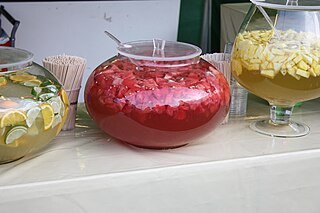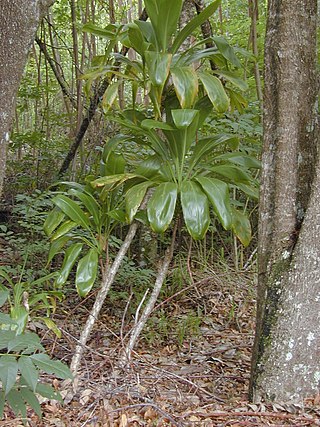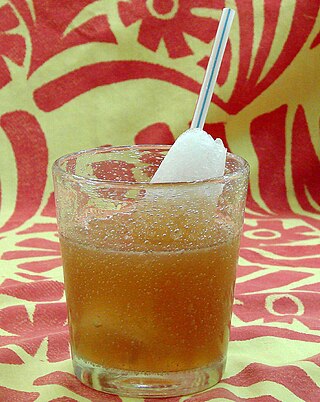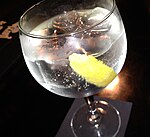
The Mai Tai is a cocktail made of rum, Curaçao liqueur, orgeat syrup, and lime juice. It is one of the characteristic cocktails in Tiki culture.

French 75 is a cocktail made from gin, champagne, lemon juice, and sugar. It is also called a 75 Cocktail, or in French simply a Soixante Quinze.

The sidecar is any cocktail traditionally made with cognac, orange liqueur, plus lemon juice. In its ingredients, the drink is perhaps most closely related to the older brandy crusta, which differs both in presentation and in proportions of its components.

The term punch refers to a wide assortment of drinks, both non-alcoholic and alcoholic, generally containing fruits or fruit juice. The drink was introduced from the Indian subcontinent to England by employees of the East India Company in the late 17th century. Punch is usually served at parties in large, wide bowls, known as punch bowls.

Punsch refers to a specific type of alcoholic liqueur and punch popular in Sweden and Finland. It is most frequently described as Swedish Punsch, and while historical variations have also been called Militär Punsch, Arrack Pun(s)ch, and Caloric Pun(s)ch, punsch should not be confused with the term "punch" as used generically. It is made by the mixing of spirits with arrak tea, sugar, and water, and was first brought to Sweden from Java in 1733. The spirit arrack is the base ingredient in most punsches, also imported into Europe by the Dutch from their colony in Batavia, Dutch East Indies. Punsch usually has 25% alcohol by volume (ABV) and 30% sugar.

A sour is a traditional family of mixed drinks. Sours belong to one of the old families of original cocktails and are described by Jerry Thomas in his 1862 book How to Mix Drinks.

Okolehao is a Hawaiian alcoholic spirit whose main ingredient was the root of the ti plant. Okolehao's forerunner was a fermented ti root beverage or beer. When distillation techniques were introduced by English seamen in 1790, it was distilled into a highly alcoholic spirit.
A Scorpion Bowl is a communally shared alcoholic tiki drink served in a large ceramic bowl traditionally decorated with wahine or hula-girl island scenes and meant to be drunk through long straws. Bowl shapes and decorations can vary considerably. Starting off as a single-serve drink known as the Scorpion cocktail, its immense popularity as a bowl drink in tiki culture is attributed to Trader Vic.

The Fine Art of Mixing Drinks is a book about cocktails by David A. Embury, first published in 1948. The book is noteworthy for its witty, highly opinionated and conversational tone, as well as its categorization of cocktails into two main types: aromatic and sour; its categorization of ingredients into three categories: the base, modifying agents, and special flavorings and coloring agents; and its 1:2:8 ratio for sour type cocktails.

A "fizz" is a mixed drink variation on the older sours family of cocktail. Its defining features are an acidic juice and carbonated water. It typically includes gin or rum as its alcoholic ingredient.

The Navy Grog was a popular rum-based drink served for many years at the Polynesian-themed Don the Beachcomber restaurants; it is still served in many so-called tiki restaurants and bars. First created by Donn Beach, who almost single-handedly originated the tiki cultural fad of the 1940s and 1950s, it was one of dozens of rum concoctions that he, and later Trader Vic and numerous other imitators, sold in exotic tropical settings. Not quite as potent as the Beachcomber's more famous Zombie, it was, nevertheless, shown on the menu as being limited to two, or sometimes three, to a customer. Reportedly, Phil Spector consumed at least two Trader Vic’s Navy Grogs at the Beverly Hilton restaurant, without eating any food, the night he later killed actress Lana Clarkson.
The Modernista is a scotch whisky cocktail livened up by the addition of absinthe/pastis and arrack-based Swedish Punsch. It was listed in Ted Haigh's book Vintage Spirits and Forgotten Cocktails, and is also known as the Modern Maid cocktail. A bitter cocktail balanced by punsch, it has been called "a sophisticated, if challenging, beverage".

The Malecon is a cocktail named after the El Malecón, the winding beachfront avenue atop the seawall in Havana, Cuba.
The corpse reviver family of named cocktails are sometimes drunk as alcoholic hangover tongue-in-cheek "cures", of potency or characteristics to be able to revive even a dead person. Some corpse reviver cocktail recipes have been lost to time, but several variations commonly thought to be tied to the American Bar at the Savoy Hotel remain, especially those espoused by Harry Craddock that originally date back to at least 1930 and are still being made. Many "reviver" variations exist and the word is sometimes used as a generic moniker for any morning-after cocktail, also known as a "hair of the dog".
Blow my skull is an alcoholic punch drink that originated in mid-19th century Australia. As listed in The English and Australian Cookery Book by Edward Abbott, it calls for two pints of boiling water, sugar loaf, lime or lemon juice, one pint of ale or porter, one pint rum, and a half a pint of brandy. It has been described as a "notoriously potent alcoholic concoction".
A Boomerang cocktail is a specific cocktail dating back to the early 20th century. In the 21st century, it may also be a reference to cocktails that bartenders illegally shuttle back and forth between bars as a way of sharing experimentation or building comradery.
The test pilot cocktail is a vintage tiki drink invented by Donn Beach. Beach was known for changing his recipes over time, and multiple versions of the test pilot attributed to both him and others make the cocktail one of his more frequently imitated and varied tiki drinks. Test pilot recipes call for multiple rums and typically include the use of falernum syrup and lime juice. The more popular also include Pernod (pastis/absinthe) and bitters.
The Fog Cutter is a vintage tiki cocktail frequently attributed to being invented by Victor Bergeron that calls for a mixture of several liquors, the juice of lemon and oranges, orgeat syrup, and cream sherry. It is high in alcoholic content and has been called the "Long Island Iced Tea of exotic drinks." It has historically been served in special Fog Cutter ceramic mugs.












